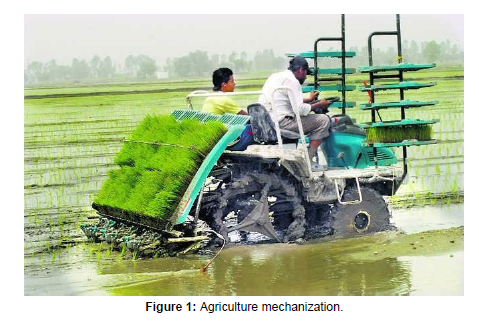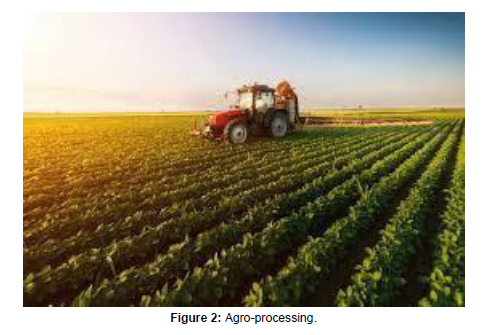Development Facilities on Rice-Based Technology
Received: 28-Apr-2023 / Manuscript No. RROA-23-99048 / Editor assigned: 01-May-2023 / PreQC No. RROA-23-99048 / Reviewed: 15-May-2023 / QC No. RROA-23-99048 / Revised: 19-May-2023 / Manuscript No. RROA-23-99048 / Published Date: 26-May-2023 DOI: 10.4172/2375-4338.1000359 QI No. / RROA-23-99048
Abstract
Despite increased rice production and area coverage in several sub-districts, rice mechanization remains limited and falls short of potential due to a lack of skilled manpower, credit, policy support, land fragmentation, lack of customized tools, farm machinery access, legislation, and other related issues. Land size, cropping pattern, and market price are the major factors determining agricultural mechanization, and the average farm size per household in the main rice production plains of Gurafarda and Fogera is 2.40 ha and 0.89 ha, respectively. Mechanizing small and non-contiguous groups of small farms is against economies of scale because the continued shrinkage in average farm size will make it difficult for individual ownership of agricultural machinery and progressively more uneconomical.
Keywords: Utilization; Imported machinery; Agriculturalmachinery; Farm Machinery; Rice-based farming; Rice processing
Keywords
Utilization; Imported machinery; Agricultural machinery; Farm Machinery; Rice-based farming; Rice processing
Introduction
Small and fragmented land holdings with subsistence agriculture are the main impediments to the promotion of agricultural mechanization in the country, as are similar conditions in Nepal. The most important details in this document are that the country’s mechanization development is hindered by a poor marketing channel and a lack of knowledge about mechanization management and utilization. Despite the existing demand for tractors, harvesters, and rice processing machines, farmers had poor access to services, such as a lack of credit to pay for hiring services and limited access to credit for the purchase and ownership of machines [1]. Additionally, the country was importing tractors and other farm implements mainly from China and Belarus, which were not up to the desired standard, resulting in poor quality of work, longer downtime, low output, and high operational costs. Besides, due to the country’s lack of foreign currency, the prices of imported machinery are very high and out of reach for poor farmers. As a result, some farmers and processors have lost faith in mechanization technologies [2]. The existing imported agricultural machinery, spare parts, and workshops in Ethiopia do not have standardized quality control facilities to ensure their quality. There should be a common facility centre for agricultural machinery and spare parts production, and agricultural machinery testing and quality certification. Implementation of appropriate-scale agricultural mechanization would be a solution for sustaining the development and growth of the sector [3]. Advisory, training, and technical services should work in collaboration with the BoA, suppliers, and dealers, and an adequate skilled workforce in the agricultural engineering field of study is critical. Private and governmental training centres are not efficiently available in rice-based farming, and the sub-sector is lacking at almost all levels of repair, maintenance, and management of farm machinery [4]. The most important details in this text are the low access to research. National rice research and development is mandated under the FNRRTC, but the agricultural mechanization workshop and laboratory facilities are not sufficiently organized [5]. Day-to-day research is conducted through the introduction of technologies from abroad, followed by validation and participatory evaluation for further adoption. External support and cooperation are inadequate, and the annual budget allocation for research is limited [6]. Domestic capital expenditure on agriculture has shown a sharp decline recently, and neither loan-based nor assistance-based financing of the sector seems to be sustainable.
Methodology
The government allocated more than 10% of its budget to agricultural development, but agricultural mechanization and its development plans should have received more attention. In Ethiopia, there is no comprehensive policy or actionable plan for agricultural mechanization [7]. In recent years, the Ministry of Agriculture and the Ethiopian Agricultural Transformation Agency initiated the Ethiopian National Agricultural Mechanization Strategy in 2014, but it has not made any deals about the rice mechanization sector [8]. This gap could be a sign of the slow expansion and development of agricultural mechanization in the country as shown in (Figure 1). Farmers in rural areas are characterized by poor road infrastructure and quality, isolation from markets, a lack of vehicles, and inefficient truck logistics, further increasing transport costs and discouraging them from commercializing their production [9]. Mechanized farming needs access from farm machinery to the crop field, but most rural areas do not have adequate farm roads. The public sector should have the role of putting in place policies to enable farmers to supply, assemble, maintain, and service farm machinery. Private repair and maintenance workshops are mostly equipped with repairing parts, but operators are not readily available at the district level [10]. After-sales service of farm machinery is also a concern, as the majority of farmers are cost-conscious.
Discussion
Ethiopia’s government offers free credit to farmers and local service providers, but it is not well organized and utilized in the Fogera and GuraFarada areas of the Amhara and SNNP regions. Local manufacturers should be supported wherever possible to create implements and equipment adapted to local circumstances [11]. Lessons to be adopted from the Chinese experience in making mechanization accessible to smallholder farmers include subsidies, strong extension services, and infrastructure development. Training of local manufacturers on small-scale mechanization technologies should be conducted on the operation, maintenance, assembly, and management of agricultural machinery [12]. Experiences from emerging countries like India, China, Brazil, Thailand, Bangladesh, Nepal, the Philippines, Myanmar, etc. show that the rapid expansion in farm machinery demand has stimulated the growth of local machinery manufacturing. Local manufacturing of farm tools and implements is another crucial factor for the sustainable development of agricultural mechanization in Ethiopia. The fabrication of metal silos is a good example of what can be done to increase their market locally and is an opportunity for the local manufacturing industry. Private sector- led mechanization has been growing, with improvements in two- wheel tractors [13]. The Nazareth Tractor Assembly Plant in Ethiopia assembles roughly 300 tractors per year, which accounted for 46% of tractors entering the Ethiopian market between 2005 and 2010. Promoting rural infrastructure investment attracts investment in agricultural infrastructure, particularly irrigation, and roads, and adds value to farm outputs through agro-processing at the community level as shown in (Figure 2). Roads should be constructed in rural areas for the movement of tractors, bulldozers, combines, and other heavy farm implements and machinery [14]. Farmers must have local access to the inputs they need, including seeds and fertilizers, electricity, and water, as well as machinery and the supporting infrastructure that mechanization requires. Despite local government pledges to guarantee the availability of electricity and access to reliable power for industrial purposes, rice processing is still a challenge and needs to be overcome before processing expansion can be realized [15].
Conclusion
Proposals to professionalize rice processing in Ethiopia include providing formal training for the operation and maintenance of rice processing facilities and increasing the availability of agricultural machinery and equipment.
Acknowledgement
None
Conflict of Interest
None
References
- Kearney M, Porter W (2009) Mechanistic niche modeling: combining physiological and spatial data to predict species’ ranges. Ecol Lett UK 12:334–350.
- Smakhtin V U (2001) Low flow hydrology: A review. J Hydrol EU 240:147–186.
- Frenken K (2005) Irrigation in Africa in figures – AQUASTAT Survey – 2005:Water Reports. FAO EU1-649.
- Beyene AM, Gashu AT, Tegegne MA, Mihertie AA (2022) Is the longstanding local rice cultivar “X-Jigna” being replaced by the improved variety “Shaga” in Fogera plain, Northwest Ethiopia? CEF UK 10:1-21.
- Biggs SA (1990) Multiple sources of innovation model of agricultural research and technology promotion. WD EU 18:1481–1499.
- Senthilkumar K, Bindraban PS, Thiyagarajan TM, Ridder ND, Giller KE (2008) Modified rice cultivation in Tamil Nadu, India: yield gains and farmers'(lack of) acceptance.Agric Syst UK 98:82-94.
- Kumar V, Ladha JK (2011) Direct Seeding of Rice: Recent Developments and Future Research Needs.Adv Agron US 111:297-413.
- Kotera A, Sakamoto T, Nguyen DK, Yokozawa M (2008) Regional consequences of seawater intrusion on rice productivity and land use in coastal area of the Mekong River Delta. Agric Environ 42:267-274.
- Pingali PL, Xuan VT (1992) Vietnam: Decollectivization and rice productivity growth. EDCC US 40:697-718.
- Ceccarelli S, Grando S (2009) Participatory plant breeding. ICARDA EU 13:1-22.
- Ceccarelli S (2012) Plant breeding with farmers – a technical manual. ICARDA, EU 92: 1-139.
- Davis FD (1989). Perceived usefulness, perceived ease of use, and user acceptance of information technology. MIS Quarterly US 13:319–339.
- Dogbe W, Marfo K, Bam R, Darte K, Ansere-Bio F (2002) Needs assessment of farmers’ rice systems and demands from varieties in Tambalug and Nyorigu Upper East Region, Ghana. CSIR AFR 155:315-327.
- Dorward P, Craufurd P, Marfo K, Dogbe W, Bam R, et al. (2007) Needs assessment of farmers’ rice systems and demands from varieties in Sayerano, Western Region, Ghana. UR AFR 40: 316-327.
Indexed at, Google Scholar, Crossref
Indexed at, Google Scholar, Crossref
Indexed at, Google Scholar, Crossref
Indexed at, Google Scholar, Crossref
Indexed at, Google Scholar, Crossref
Indexed at, Google Scholar, Crossref
Indexed at, Google Scholar, Crossref
Indexed at, Google Scholar, Crossref
Indexed at, Google Scholar, Crossref
Indexed at, Google Scholar, Crossref
Indexed at, Google Scholar, Crossref
Indexed at, Google Scholar, Crossref
Citation: Olumayowa M (2023) Development Facilities on Rice-Based Technology. J Rice Res 11: 359. DOI: 10.4172/2375-4338.1000359
Copyright: © 2023 Olumayowa M. This is an open-access article distributed under the terms of the Creative Commons Attribution License, which permits unrestricted use, distribution, and reproduction in any medium, provided the original author and source are credited.
Select your language of interest to view the total content in your interested language
Share This Article
Recommended Journals
Open Access Journals
Article Tools
Article Usage
- Total views: 2279
- [From(publication date): 0-2023 - Jan 17, 2026]
- Breakdown by view type
- HTML page views: 1900
- PDF downloads: 379


